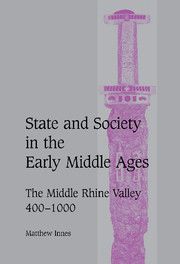Book contents
- Frontmatter
- Contents
- List of figures
- List of abbreviations
- A note on nomenclature and citations
- Acknowledgements
- Map 1 The Carolingian Rhineland
- Map 2 The Carolingian middle Rhine valley
- 1 INTRODUCTION
- 2 MONASTICISM, SPIRITUAL PATRONAGE AND SOCIAL STRUCTURE
- 3 LAND, KINSHIP AND STATUS
- 4 LOCAL POWER: COLLECTIVE ACTION, CONFLICT AND CONSENSUS
- 5 LOCALITY AND CENTRE: MECHANISMS OF EXTRACTION
- 6 POLITICAL POWER FROM THE FIFTH TO THE ELEVENTH CENTURY
- 7 CONCLUSION: STATE AND SOCIETY IN THE EARLY MEDIEVAL WEST
- List of primary sources
- Bibliography of secondary works
- Index
- Cambridge Studies in Medieval Life and Thought Fourth series
2 - MONASTICISM, SPIRITUAL PATRONAGE AND SOCIAL STRUCTURE
Published online by Cambridge University Press: 10 July 2009
- Frontmatter
- Contents
- List of figures
- List of abbreviations
- A note on nomenclature and citations
- Acknowledgements
- Map 1 The Carolingian Rhineland
- Map 2 The Carolingian middle Rhine valley
- 1 INTRODUCTION
- 2 MONASTICISM, SPIRITUAL PATRONAGE AND SOCIAL STRUCTURE
- 3 LAND, KINSHIP AND STATUS
- 4 LOCAL POWER: COLLECTIVE ACTION, CONFLICT AND CONSENSUS
- 5 LOCALITY AND CENTRE: MECHANISMS OF EXTRACTION
- 6 POLITICAL POWER FROM THE FIFTH TO THE ELEVENTH CENTURY
- 7 CONCLUSION: STATE AND SOCIETY IN THE EARLY MEDIEVAL WEST
- List of primary sources
- Bibliography of secondary works
- Index
- Cambridge Studies in Medieval Life and Thought Fourth series
Summary
GIFTS TO THE CHURCH: PATTERNS AND POTENTIAL
‘Total history’ is an impossibility, because in studying any historical society we are totally reliant on the highly selective and carefully selected views transmitted to us by that society and its successors. Any serious attempt at reconstructing a past society must therefore begin by confronting the problem of the representativeness or otherwise of the surviving sources. The evidence which survives from the early medieval period is only a tiny subset of what once existed, but its survival is not necessarily random. Those documents which were transmitted were not just lucky enough to avoid the random variables of destruction and loss; most were copied because of conscious decisions made to preserve them by later generations.
In the Carolingian middle Rhine, documents were copied in large numbers because they recorded an important process of social change, which saw monasteries acquiring rights over land on an unprecedented scale. If we consider what is lost, it is clear that more or less random destruction through decay, war or natural disaster played a part: hence the absence of Carolingian material from the archives of the cathedrals of Mainz, Worms and Speyer. Similarly, the abbey of Hersfeld preserved the originals of its royal grants, but not documents recording its dealings with non-royal individuals. The odd non-royal documents that do survive from Hersfeld are, essentially, lucky: three ninth-century charters were used as bookbindings in the tenth century and thus preserved and later rediscovered.
- Type
- Chapter
- Information
- State and Society in the Early Middle AgesThe Middle Rhine Valley, 400–1000, pp. 13 - 50Publisher: Cambridge University PressPrint publication year: 2000

